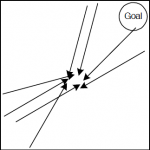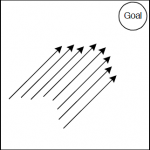The stages of team development are already well-described in various places and so going into great detail here would serve little purpose. I will, however, provide a brief overview since I think more leaders would benefit from being aware of these stages and because I’d like to use these terms in future posts.
Overview
New teams travel through four stages of team development before reaching high levels of performance. The different makeup of each team means that no two teams progress through these stages at the same rate (or with the same result). There’s no guarantee that progress will always be forward: it is possible for teams to regress back to an earlier stage due to some conflict or upset in some balance. And some teams may never reach a state of high performance.
Each stage must be passed through before tackling the next. Some teams will be able to spend less time in some of the stages, but it’s not possible to just jump to the end and skip the beginning stages.
Forming
The team organizes excitedly, usually with some unrealistic expectations. Since members are still getting oriented, the leader provides much of the purpose and direction. Roles and even the goals are unclear. In some cases, process is ignored or is in the early stages of being developed.
Team members are polite and usually defer to someone expressing an opinion. They want to be accepted, so not much happens to rock the boat. There is usually very little alignment. This stage can sometimes be characterized as a game of “pickup sticks”.
Storming
The team’s initial expectations hit reality as they start to get some experience working with one another. Subgroups form, usually in competing alignments. Morale will definitely take a hit. The team’s purpose is usually clarified but not everything has been answered yet.
Productivity will be low and some members may want to drop out.
The individual roles become a source of conflict as team members strive to find where they fit and which role to play.
Norming
Clarity of purpose, roles, goals and team values become better defined and accepted. More tasks are accomplished partly due to increases in skill but also because communication and trust has improved. Morale is improving but not high yet. Productivity has seen a marked increase and the team realizes that even more is possible.
There can be a tendency to backtrack into Storming when an issue comes up. The lessons learned there can decrease the time spent before returning to Norming.
Performing
Productivity and morale are both high. These two characteristics feed off and reinforce each other.
Everyone understands their role, the team’s purpose and what the goal is. There is a very real sense that team members are proud of the team and what they’re doing. The team often takes care of itself with little instruction or assistance. Sometimes teams in this stage can be accused of steamrolling over the competition.
Conclusion
This model enables us to anticipate what a team is likely to go through at certain points in its development.
It is helpful to know that a particular struggle is “normal” and can be worked through. This awareness helps to depersonalize the issues at hand as the team members constructively work through them. By understanding the stages and identifying the symptoms, managers find themselves in better positions to lead their teams to levels of higher performance.
What do you think? Is this a new concept to you or are you familiar with these stages? Do you have any experiences or stories to add? Comment here or privately to JeffreyGifford (at) gmail (dot) com.
Some of this post (including the artwork) is inspired by a document I developed in late 2005 published under a Creative Commons Attribution-NonCommercial-ShareAlike 2.5 License.
Much credit is given to Bruce Tuckman for the “Forming, Storming, Norming, Performing” descriptions developed in the mid 1960’s.






Many thanks to the editor who emailed me a couple of verb-subject agreement corrections. Try as I do to find all the errors beforehand, it seems that a few sneak by.
The same editor was kind enough to email me some of their thoughts on this post:
Thanks for sharing these thoughts—I had already planned on writing about why management breaks up functional teams in another post!
It’s been a while since I’d given this any thought. But I’ve been so challenged at work by poorly performing teams, and a lack of teamwork, that I’ve been going out of my mind. Then it hit me, “I need to revisit my Wood Badge Training! (Bobwhite, C-12-10)”
A quick search brought me to your blog, this post, and a wealth of information! I’m thrilled to have found your blog. Being an IT Manager, your posts are really pertinent. This post, in particular, really sums up the team development theory, and has served as encouragement to press on, and overcome some of the challenges I’m facing.
Thank You.
Chris, I’m glad this was helpful! The document I worked on in 2005 that became the basis of this post was an attempt to process what I learned from my own WoodBadge training (Eagle, C-33-05), some of the best hands-on leadership training I’ve ever received.
I do encourage you to press on, do your best and work toward overcoming those challenges. It can take time, though. And it may be that not all challenges can be overcome—some of your team may not be up to the challenge or perhaps you’re facing a sub-challenge and not the primary one.
In any event, if you’ve taken the WoodBadge course, you’re quite likely well-equipped to straighten out whatever you’re facing!
Thanks for commenting,
—
Jeffrey
PS. I like what they did with the C-12-10 course and the individual teams (your Bobwhite here). Congratulations on finishing the course and your projects! –JG